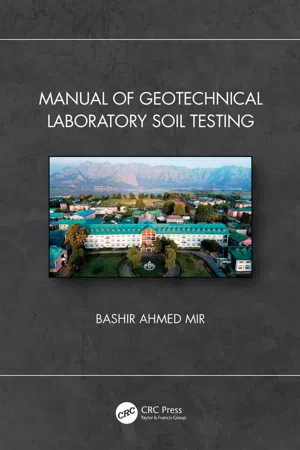
Manual of Geotechnical Laboratory Soil Testing
Bashir Ahmed Mir
- 374 páginas
- English
- ePUB (apto para móviles)
- Disponible en iOS y Android
Manual of Geotechnical Laboratory Soil Testing
Bashir Ahmed Mir
Información del libro
Manual of Geotechnical Laboratory Soil Testing covers the physical, index, and engineering properties of soils, including compaction characteristics (optimum moisture content), permeability (coefficient of hydraulic conductivity), compressibility characteristics, and shear strength (cohesion intercept and angle of internal friction). Further, this manual covers data collection, analysis, computations, additional considerations, sources of error, precautionary measures, and the presentation results along with well-defined illustrations for each of the listed tests. Each test is based on relevant standards with pertinent references, broadly aimed at geotechnical design applications.
FEATURES
-
- Provides fundamental coverage of elementary-level laboratory characterization of soils
-
- Describes objectives, basic concepts, general understanding, and appreciation of the geotechnical principles for determination of physical, index, and engineering properties of soil materials
-
- Presents the step-by-step procedures for various tests based on relevant standards
-
- Interprets soil analytical data and illustrates empirical relationship between various soil properties
-
- Includes observation data sheet and analysis, results and discussions, and applications of test results
This manual is aimed at undergraduates, senior undergraduates, and researchers in geotechnical and civil engineering.
Prof. (Dr.) Bashir Ahmed Mir is among the senior faculty of the Civil Engineering Department of the National Institute of Technology Srinagar and has more than two decades of teaching experience. Prof. Mir has published more than 100 research papers in international journals and conferences; chaired technical sessions in international conferences in India and throughout the world; and provided consultancy services to more than 150 projects of national importance to various government and private agencies.